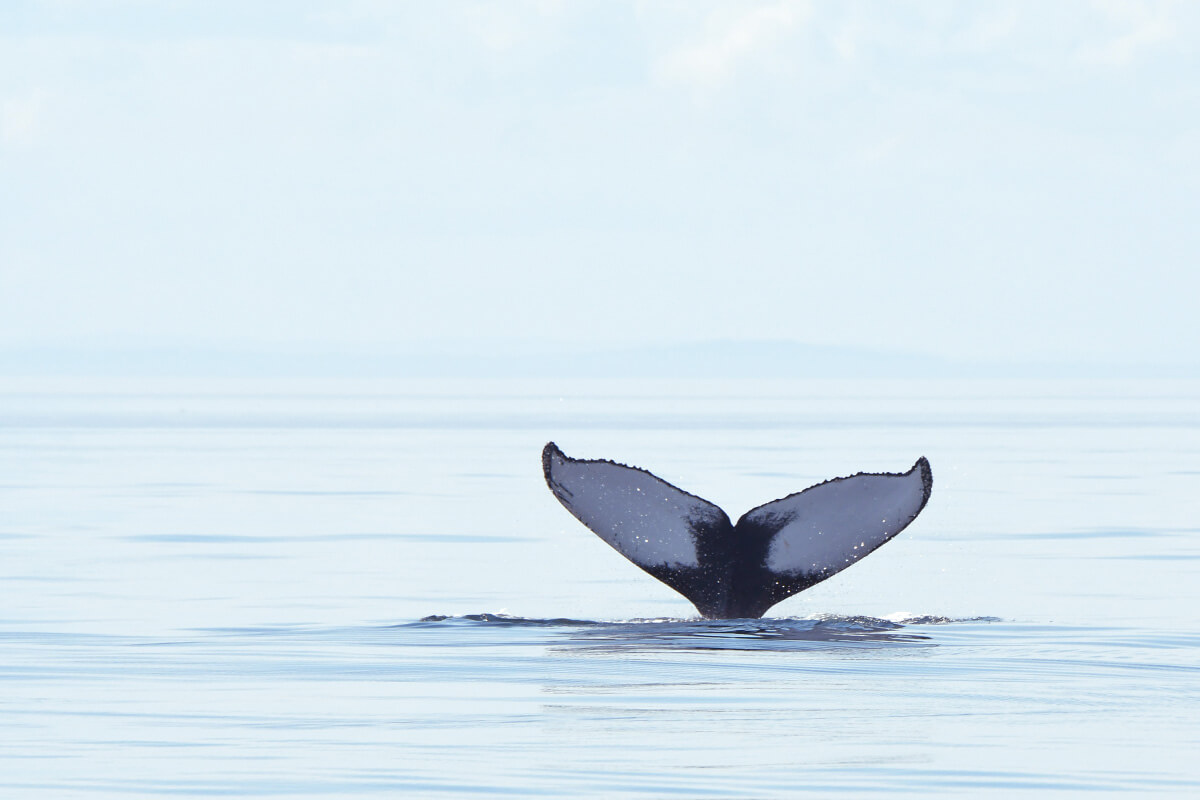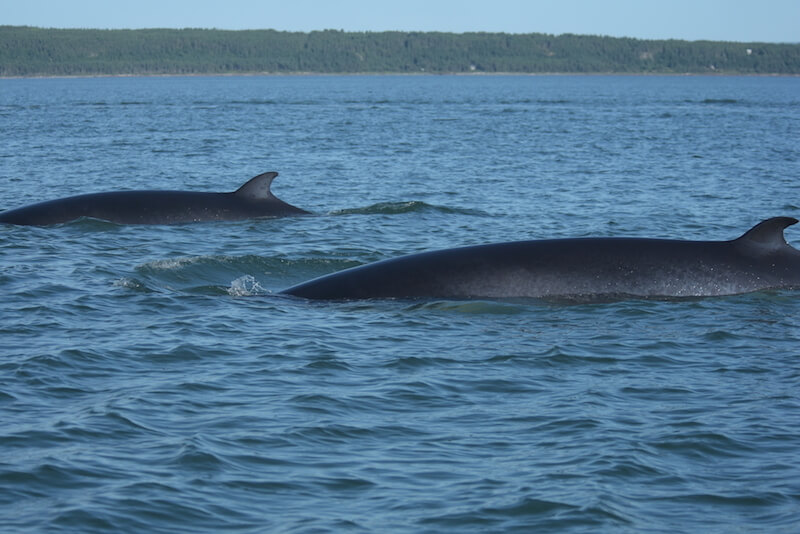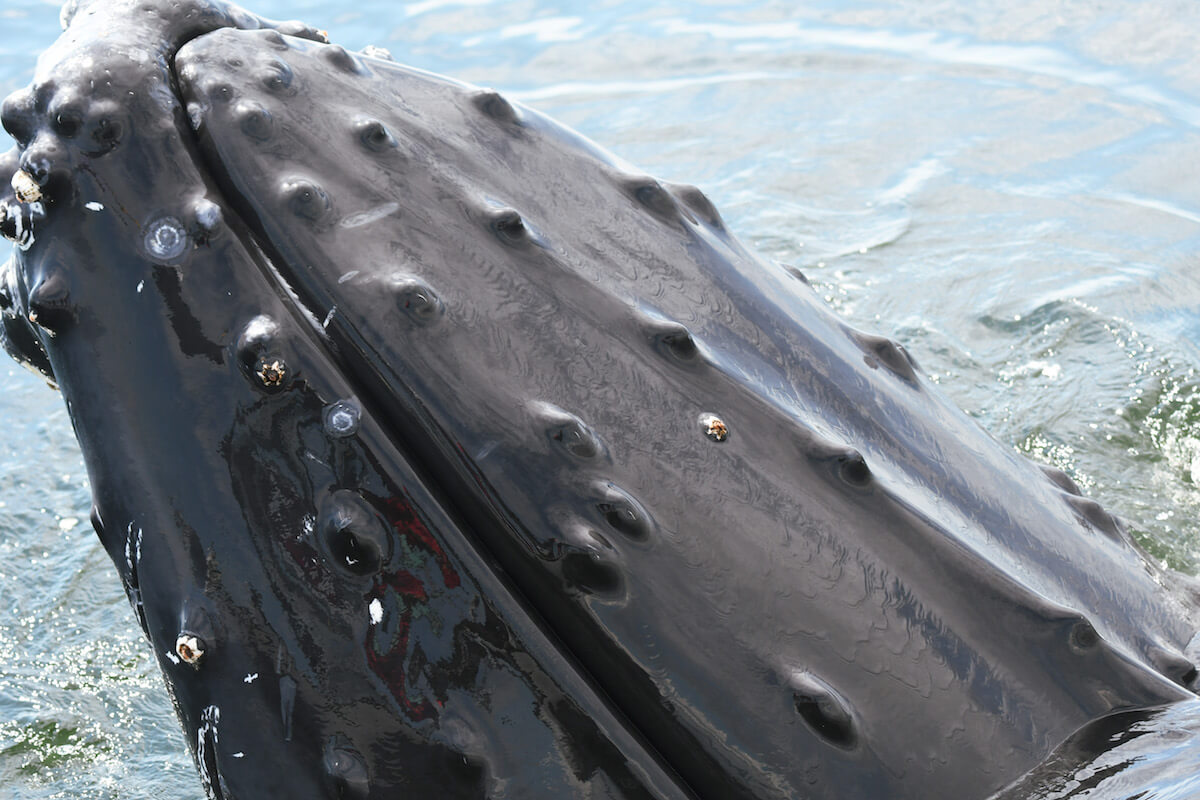Atlantic white-sided dolphins by the hundreds, fin whales by the dozens, acrobatic humpbacks: observers in the Gaspé have had plenty to gaze at over the past few days, that is when their view wasn’t being obscured by the fog!
On July 25, an observer sets sail late in the day, with the impression she is heading to Land’s End, as Cap Gaspé is sometimes nicknamed. The horizon stretches out in front of her as far as the eye can see. All of a sudden, a sharp fin slices through the water surface. Nothing like the sickle-shaped dorsal of the minke whale or the triangular fin of the harbour porpoise. Another fin cuts through the waves. This time, she recognizes the species: Atlantic bluefin tuna! They must have found some small fish to feed on, as they are soon joined by white-sided dolphins. But the smörgåsbord isn’t just for toothed animals. Baleen whales join the feast: five or six fin whales cash in on the action while farther offshore, a humpback slaps its tail and pectoral fin on the surface. Is this its way of summoning its peers to the schools of fish? Maybe!
On the evening of July 26 in Baie-des-Sables, a crowd gathers on the docks.One resident decides to go see what’s going on. A second gentleman points the first to an area of churning waters. The witness grabs his binoculars to get a better look. A large school of small, smelt-like fish is being chased by larger fish. He seems to think they are striped bass. A minke whale rushes in. A second individual arrives, darting straight into the school. The bubbling at the surface subsides. It must be a furious chase down below! Then, in the middle of it all, a dolphin leaps out of the water. Observers enjoy the splashing caused by this hunting foray for an hour, against a backdrop of a sun-tinted sky.
Minke or fin?
On the other side of the St. Lawrence, in Franquelin, an observer wonders if he is watching a minke whale or a fin whale. “From afar I find it easy, but when whales surface near my boat, they all look so big!”
There are a few clues that can help differentiate these two species. The appearance of a minke whale on the surface will only last one or two seconds, while a surfacing fin whale will be visible a little longer. A fin whale’s blowhole is prominent while that of a minke whale is rather inconspicuous. Additionally, the spout of a minke whale is generally invisible, while that of a fin whale is more distinct and, especially, very, very loud.
Côte-Nord teeming with life
On July 23, near the island of Grand Caoui off the coast of Port-Cartier, Jacques Gélineau carries out his photo-identification work. That day, he spots two blue whales, three minke whales, a humpback, grey seals and harbour porpoises. After a few very quiet weeks in the area, it’s encouraging to see so much life. On July 26, he also identifies two blue whales: B033 and B058.
In the Saguenay-St. Lawrence Marine Park, when the fog burns off, observations abound. Fin whales and humpbacks are present in numbers, as are minke whales and harbour porpoises. For an overview of individuals present in the sector, check out the field notes of Timothée Perrero, research assistant for the Group for Research and Education on Marine Mammals (GREMM).
From Guadeloupe to the St. Lawrence
Photos posted on social media sometimes result in identifications that add a chapter to the life story of a given individual. For the past few days, the humpback H930 has been plying the waters of the Saguenay-St. Lawrence Marine Park. But in March 2020, it was photographed off Guadeloupe by the network OMMAG Guadeloupe! The humpback whales that frequent the St. Lawrence usually winter near the Dominican Republic. This is an extremely interesting observation then!
Kudos to everyone involved in this “match”, including Renaud Pintiaux, Whales Online employee and the person who submitted the photo, as well as Mathieu Marzelière, one of GREMM’s research assistants.
H930 is the number attributed to this humpback in the St. Lawrence Humpback Whale Catalogue managed by the Mingan Island Cetacean Study. There is currently no standardized catalogue for North Atlantic humpback whales.
Where are the whales this week?
It gives an idea of the presence of whales and does not at all represent the actual distribution of whales in the St. Lawrence. Use it for fun!









